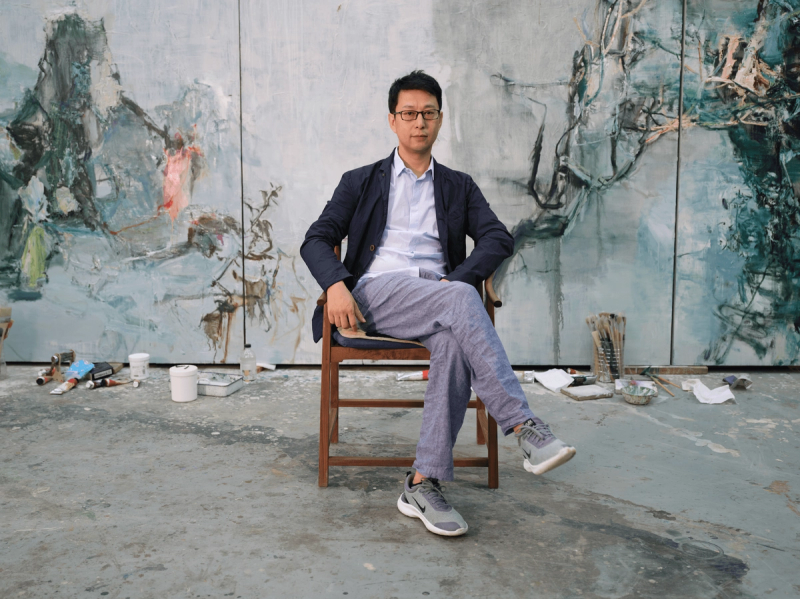Tu Hongtao (Born–2025)
“Time passes, moves and changes. I can’t stare at time, but I can stare at the landscape. I see light, movement… and occasionally I fall into a completely abstract mystery.”
In sweeping compositions, Tu Hongtao revisits Eastern and Western traditions of landscape painting to reconsider the representation of space and time. Based in Chengdu, Tu draws on influences that range from the East Jin Dynasty to today, including the innovations of classical scroll painters Gu Kaizhi and Dong Qichang, the abstract gestures of painters Cy Twombly and Brice Marden, and the photocollages of David Hockney. His dynamic canvases convey encounters with nature experienced through multiple spatial, temporal, and cultural perspectives.
Born in 1976 in Chengdu, Tu studied oil painting at the China Academy of Art, Hangzhou. His early Neo-Pop paintings featured cityscapes populated with bodies, reflecting anxieties connected to the rapid social and environmental transformations accompanying China’s economic reform and globalization at the end of the century. In 2008, Tu moved to a studio in rural Chengdu and studied the Chinese literati tradition of landscape painting as well as Yuan Dynasty artist Zhao Mengfu’s theory of the common origins of calligraphy and painting. He frequently visited the mountainous Bifeng Valley in Sichuan during this period, drawing on the terrain for inspiration. As a result, his paintings shifted from mimetic portrayals to illusionistic and psychologically charged realms.
Since 2010, Tu’s compositions have grown increasingly complex, featuring a single landscape layered many times over to redirect any linear experience of the work’s narrative elements, sometimes to suggest the very disappearance of perspective. His brushwork amplifies the precise movements of calligraphy, the curved wrist’s twists and turns, expanding it into a performative form. Among the recent solo exhibitions dedicated to the artist’s work, in 2018, the Long Museum in Shanghai organized Tu Hongtao: A Timely Journey, which traveled to the Long Museum, Chongqing. His work can be found in such public collections as the Long Museum, Shanghai; Museum of Contemporary Art, Yinchuan; Power Station of Art, Shanghai; White Rabbit Gallery, Sydney; and Guangdong Museum of Art.
Exhibitions
- Tu Hongtao: Beyond Babel
- Lévy Gorvy Dayan, New York
- February 22 - March 30, 2024
- Tu Hongtao: Dusk
- LGDR, Paris
- September 3 - October 8, 2022
- Tu Hongtao: Drunken Forest
- Lévy Gorvy, Palm Beach
- February 9 - February 28, 2021
- Tu Hongtao: Twisting and Turning
- Lévy Gorvy, London
- October 2 - November 24, 2020
- Tu Hongtao
- Lévy Gorvy, Hong Kong
- March 25 - June 23, 2020
Selected Artworks
- Tu Hongtao
- Tower of Babel, 2023
- Oil and oilstick on canvas
- 82¹¹⁄₁₆ × 126 inches (210 × 320 cm)
- Tu Hongtao
- Genghis Khan with a Telegraph Machine, 2022–23
- Oil and oilstick on canvas
- 82¹¹⁄₁₆ × 126 inches (210 × 320 cm)
- Tu Hongtao
- I Am Wandering in the Mountains, 2023
- Oil and oilstick on canvas
- 82¹¹⁄₁₆ × 106⁵⁄₁₆ inches (210 × 270 cm)
- Tu Hongtao
- Run, Boar, Run!, 2022-23
- Oil and oilstick on canvas
- 82¹¹⁄₁₆ × 126 inches (210 × 320 cm)
Selected Press
- GalleriesNowNovember 19, 2020
- HyperallergicDecember 19, 2020
- The Art NewspaperNovember 4, 2020
- Harper's Bazaar ArtNovember 1, 2020
- Black QubeOctober 19, 2020
- The Art NewspaperOctober 15, 2020
- InssaidorOctober 13, 2020
- Seb's Art ListOctober 1, 2020
- GalleriesNowJune 12, 2020
- ArtronMay 18, 2020
- Prestige MagazineMay 15, 2020
- Financial TimesApril 27, 2020
- ArtDailyApril 2, 2020
- SohuNovember 6, 2019
- YohomarsNovember 6, 2019
- ArtnetOctober 14, 2019
- CryptopolitanMarch 10, 2024
- ArtnetMarch 9, 2024
- Artnet ChinaMarch 8, 2024
- Town & CountryMarch 4, 2024
